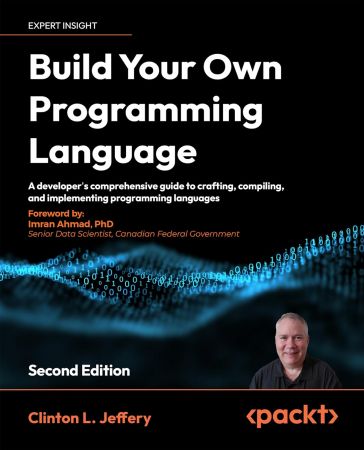Build your own Programming Language, 2nd Edition


Build your own Programming Language, 2nd Edition
English | 2024 | ISBN: 1804618020 | 557 pages | True/Retail PDF EPUB | 23.4 MB
Embark on a journey through essential components of language design, compiler construction, preprocessors, transpilers, and runtime systems in this second edition, authored by the creator of the Unicon programming language.
Purchase of the print or Kindle book includes a free PDF eBook
Key Features
Takes a hands-on approach; learn by building the Jzero language, a subset of Java, with example code shown in both the Java and Unicon languages
Learn how to create parsers, code generators, scanners, and interpreters
Target bytecode, native code, and preprocess or transpile code into a high-level language
Book Description
There are many reasons to build a programming language: out of necessity, as a learning exercise, or just for fun. Whatever your reasons, this book gives you the tools to succeed.
You’ll build the frontend of a compiler for your language and generate a lexical analyzer and parser using Lex and YACC tools. Then you’ll explore a series of syntax tree traversals before looking at code generation for a bytecode virtual machine or native code. In this edition, a new chapter has been added to assist you in comprehending the nuances and distinctions between preprocessors and transpilers. Code examples have been modernized, expanded, and rigorously tested, and all content has undergone thorough refreshing. You’ll learn to implement code generation techniques using practical examples, including the Unicon Preprocessor and transpiling Jzero code to Unicon. You’ll move to domain-specific language features and learn to create them as built-in operators and functions. You’ll also cover garbage collection.
Dr. Jeffery’s experiences building the Unicon language are used to add context to the concepts, and relevant examples are provided in both Unicon and Java so that you can follow along in your language of choice.
By the end of this book, you’ll be able to build and deploy your own domain-specific language.
What you will learn
Analyze requirements for your language and design syntax and semantics.
Write grammar rules for common expressions and control structures.
Build a scanner to read source code and generate a parser to check syntax.
Implement syntax-coloring for your code in IDEs like VS Code.
Write tree traversals and insert information into the syntax tree.
Implement a bytecode interpreter and run bytecode from your compiler.
Write native code and run it after assembling and linking using system tools.
Preprocess and transpile code into another high-level language
Who this book is for
This book is for software developers interested in the idea of inventing their own language or developing a domain-specific language. Computer science students taking compiler design or construction courses will also find this book highly useful as a practical guide to language implementation to supplement more theoretical textbooks. Intermediate or better proficiency in Java or C++ programming languages (or another high-level programming language) is assumed.
Table of Contents
Why Build Another Programming Language?
Programming Language Design
Scanning Source Code
Parsing
Syntax Trees
Symbol Tables
Checking Base Types
Checking Types on Arrays, Method Calls, and Structure Accesses
Intermediate Code Generation
Syntax Coloring in an IDE
Preprocessors and Transpilers
Bytecode Interpreters
Generating Bytecode
Native Code Generation
Implementing Operators and Built-In Functions
Domain Control Structures
Garbage Collection
Final Thoughts
Appendix: Unicon Essentials
Answers





